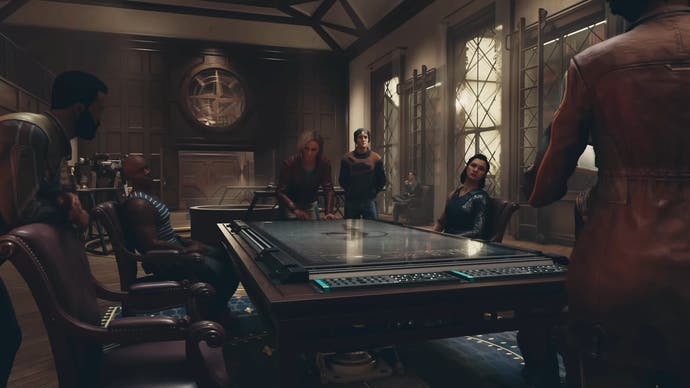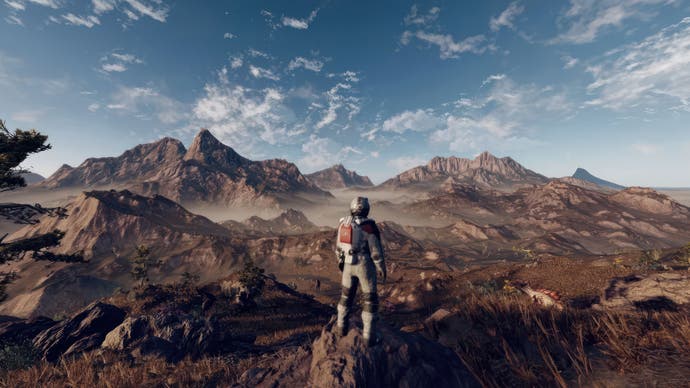The Starfield tech breakdown: why it runs at 30 frames per second
The DF team discuss visuals and the massive scale and scope of the game.
Bethesda's 45-minute deep dive into Starfield was one of the most fascinating parts of the summer games conferences, offering a huge amount of insight into the technical underpinnings of one of the most ambitious upcoming games. After taking the time to investigate it more deeply, John Linneman and Alex Battaglia have reunited to discuss the Starfield Direct in detail - covering everything from the reasons behind the game's 30fps console target, what 4K on Series X actually means, the implications for Series S and the rendering tech on display.
First up: the frame-rate elephant in the room, which wasn't actually discussed in the show itself. Todd Howard later stated in an interview with IGN that the game would run at a locked 30fps for consistency, with a 4K output resolution on Series X and 1440p for Series S. It's not unusual to see Series X releases run at 4K 30fps, but it is slightly rarer to see no option for a lower resolution target and perhaps reduced settings to hit 60fps instead. So why doesn't Starfield offer this option?
The answer is more nuanced than you might expect. John puts forward the argument that a frame-rate target is a design decision - after all, even consoles in the 80s could hit 60fps, but clearly many developers have opted for a 30fps experience instead in the decades since. The question is what frame-rate allows you to hit your design goals for the game? In the case of Starfield, it's clear that this is an open-world or even "open universe" game, with item permanence, AI, simulations, and a lot of interlocking systems to create an immersive experience.
- 00:00 Overview
- 00:53 Why is Starfield 30fps on consoles?
- 12:31 Visual impressions and real-time global illumination
- 17:15 Reflections and motion blur
- 23:31 Screen-space shadows and terrain rendering
- 28:06 Volumetric lighting, fog, and bokeh depth of field
- 32:40 Character rendering
- 36:01 Gameplay impressions
With all of the CPU demands that this sort of a game entails then, dropping the resolution might not have much of an effect on the overall frame-rate. As a developer, you may as well crank up the visuals and embrace that 30fps output for an overall more consistent output, knowing as well that the PC release ought to run at 60fps for those that need a higher frame-rate and have machines capable of delivering it.
The expectation of 4K 60fps also somewhat ignores the fact that most AAA games run at sub-4K internal resolutions anyway, which are then scaled up to a 4K output using FSR 2 or other techniques. Based on pixel counting the Starfield trailer, one scene featured an internal resolution of 1296p (60 percent of 4K). In that kind of a scenario, you have much less latitude in reducing resolution further to boost performance compared to native 4K.
Time will tell how well Bethesda's target frame-rate is maintained, but in general a consistent, properly frame-paced 30fps feels better than a game that runs unlocked in the 30-60fps range (as we saw in Star Wars Jedi: Survivor and the Final Fantasy 16 demo) - so the decision at least makes sense from that perspective.

Beyond the frame-rate, John calls out Starfield as being the first truly beautiful game that Bethesda has ever made - and a lot of that comes down to improvements to rendering techniques, particularly the use of real-time global illumination, reflections and motion blur.
The global illumination doesn't appear to be a per-pixel solution based on ray tracing from the shots in the trailer, but it still makes a big difference to the look of Starfield with more realistic shadows and lighting that takes on the colour and directionality of its source. Obviously creating baked lighting for the many many areas in the game would be a challenging task, so having a dynamic solution makes a lot of sense.
Reflections on shiny surfaces are also handled in a different way than in past Bethesda games, as real-time cube maps are used - something we also spotted in Horizon Forbidden West and Gran Turismo 7 - instead of screen space reflections. This likely ties in with the global illumination, with both the GI and reflections updating every so often so keep lighting, shadows and reflections in line with reality. This is a cheaper solution than RT alternatives, and again makes sense given the breadth and number of the explorable locations in the game.

Per-object, per-pixel motion blur has also been added to the game - and this contributes perhaps more than anything else to the overall look and feel of the game in motion. Interestingly, id Software contributed to the implementation of motion blur in Starfield, based on their expertise with the technique in Doom Eternal. Motion blur is incredibly important to maximise the perceived fluidity of 30fps titles, so given Starfield's focus on gunplay its inclusion - as well as a more dynamic camera and solid animation work - is canny.
Screen-space shadows are another new feature added to the Creation Engine for Starfield, and here they help to provide shadows for fine detail like player's hands and gun models as well as environmental details like small rocks and grass. This, in combination with boosts to ground detail (potentially by hardware tessellation), means terrain doesn't have the tiled appearance common to previous Bethesda open world titles and really looks fantastic.
Above the ground, there appears to be fairly good simulation of atmospheric phenomena, such as light scattering and long-range volumetric fog of a kind we don't normally see - only games like Horizon Forbidden West and Red Dead Redemption 2 have managed to maintain realistic fog and shadowing well out into the distance, helping sell the reality of long vistas. These far-field rendering techniques are something that Halo Infinite still lacks, so it's important that it's been included in the visual feature set here given the game's scope.

While these additions have shown a clear progression from Fallout 4, character rendering and animation during dialogue sequences remains something of a weak point. While a nice bokeh depth of field is applied here - and in other settings to great effect - the faces look a little flat, without much in the way of emotion, giving them an uncanny valley feeling. This is a bit of a surprise given the graphical leaps elsewhere - and more convincing progression in this sort of rendering between the first and second Horizon games, for instance.
Despite this disappointment, Starfield as a whole impresses as a visual showcase - and the gameplay looks solid too. The gunplay looks much weightier, first and third-person cameras work well, and the system for highlighting actionable items in the game world is clean and easily parseable. The inventory and menus as a whole look great, with a distinct style based on that 'NASA-punk' aesthetic that doesn't sacrifice clarity.
There's still plenty to discover about Starfield of course, so we'll be paying close attention to its graphics, gameplay and systems as we approach its 6th of September release date - less than three months away now. Success or failure though, Starfield looks destined to be one of the most fascinating releases of 2023.










